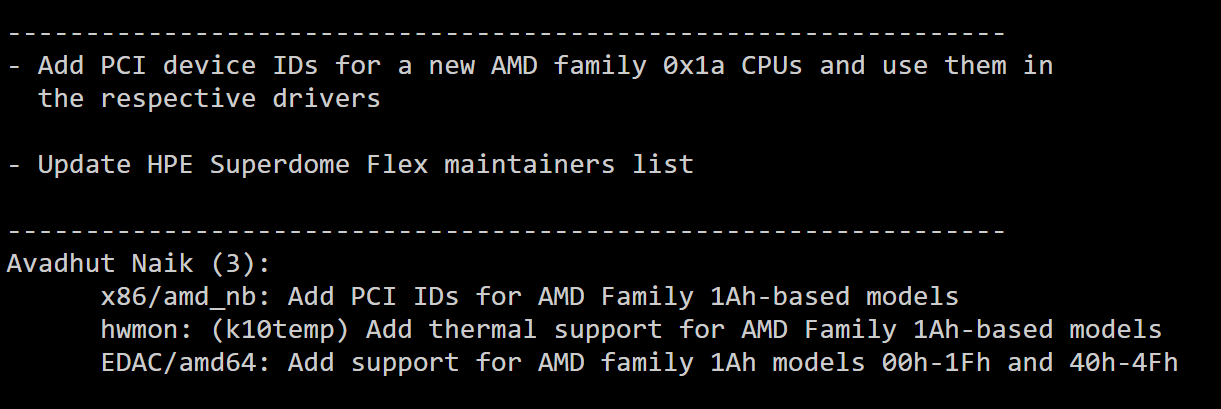 Technology peripherals
Technology peripherals
 It Industry
It Industry
 AMD Zen 5 processors have begun supporting Linux 6.6 preliminary submissions
AMD Zen 5 processors have begun supporting Linux 6.6 preliminary submissions
AMD Zen 5 processors have begun supporting Linux 6.6 preliminary submissions
AMD’s next-generation Zen 5 CPU has begun to provide support for Linux 6.6 and has submitted relevant code. The latest patches include features such as temperature monitoring and EDAC reporting

In the latest Linux 6.6 code, a number of patches have been added that include support for hardware Monitor temperature monitoring and EDAC reporting capabilities. In addition, the new version also incorporates x86/misc patches, which Phoronix reports are to assign PCI device IDs to "Family 1Ah" processors and prepare for their future integration into the EDAC and k10temp CPU drivers
Linux users have a very clear preference for the AMD platform. Currently, the AMD platform is arguably the most popular choice among Linux users and has captured the majority of the market share. Perhaps it is for this reason that AMD has changed its previous lazy attitude and is now actively cooperating with Linux development efforts
In addition, the company has been actively upgrading the RADV Vulkan driver, aiming to make Linux a more accessible platform. The platform
The AMD Zen 5 processor expected to be launched in 2024 will adapt to the AM5 platform and bring a series of architectural updates. Please continue to pay attention to the follow-up reports of this site, and stay tuned
Advertising statement: This article contains external jump links (including but not limited to hyperlinks, QR codes, passwords, etc.), aiming to provide more More information, saving time for screening, for reference only. Please note that all articles on this site contain this statement
The above is the detailed content of AMD Zen 5 processors have begun supporting Linux 6.6 preliminary submissions. For more information, please follow other related articles on the PHP Chinese website!

Hot AI Tools

Undresser.AI Undress
AI-powered app for creating realistic nude photos

AI Clothes Remover
Online AI tool for removing clothes from photos.

Undress AI Tool
Undress images for free

Clothoff.io
AI clothes remover

Video Face Swap
Swap faces in any video effortlessly with our completely free AI face swap tool!

Hot Article

Hot Tools

Notepad++7.3.1
Easy-to-use and free code editor

SublimeText3 Chinese version
Chinese version, very easy to use

Zend Studio 13.0.1
Powerful PHP integrated development environment

Dreamweaver CS6
Visual web development tools

SublimeText3 Mac version
God-level code editing software (SublimeText3)

Hot Topics
 1665
1665
 14
14
 1423
1423
 52
52
 1321
1321
 25
25
 1269
1269
 29
29
 1249
1249
 24
24
 Linux Architecture: Unveiling the 5 Basic Components
Apr 20, 2025 am 12:04 AM
Linux Architecture: Unveiling the 5 Basic Components
Apr 20, 2025 am 12:04 AM
The five basic components of the Linux system are: 1. Kernel, 2. System library, 3. System utilities, 4. Graphical user interface, 5. Applications. The kernel manages hardware resources, the system library provides precompiled functions, system utilities are used for system management, the GUI provides visual interaction, and applications use these components to implement functions.
 How to check the warehouse address of git
Apr 17, 2025 pm 01:54 PM
How to check the warehouse address of git
Apr 17, 2025 pm 01:54 PM
To view the Git repository address, perform the following steps: 1. Open the command line and navigate to the repository directory; 2. Run the "git remote -v" command; 3. View the repository name in the output and its corresponding address.
 vscode Previous Next Shortcut Key
Apr 15, 2025 pm 10:51 PM
vscode Previous Next Shortcut Key
Apr 15, 2025 pm 10:51 PM
VS Code One-step/Next step shortcut key usage: One-step (backward): Windows/Linux: Ctrl ←; macOS: Cmd ←Next step (forward): Windows/Linux: Ctrl →; macOS: Cmd →
 How to run java code in notepad
Apr 16, 2025 pm 07:39 PM
How to run java code in notepad
Apr 16, 2025 pm 07:39 PM
Although Notepad cannot run Java code directly, it can be achieved by using other tools: using the command line compiler (javac) to generate a bytecode file (filename.class). Use the Java interpreter (java) to interpret bytecode, execute the code, and output the result.
 How to run sublime after writing the code
Apr 16, 2025 am 08:51 AM
How to run sublime after writing the code
Apr 16, 2025 am 08:51 AM
There are six ways to run code in Sublime: through hotkeys, menus, build systems, command lines, set default build systems, and custom build commands, and run individual files/projects by right-clicking on projects/files. The build system availability depends on the installation of Sublime Text.
 laravel installation code
Apr 18, 2025 pm 12:30 PM
laravel installation code
Apr 18, 2025 pm 12:30 PM
To install Laravel, follow these steps in sequence: Install Composer (for macOS/Linux and Windows) Install Laravel Installer Create a new project Start Service Access Application (URL: http://127.0.0.1:8000) Set up the database connection (if required)
 What is the main purpose of Linux?
Apr 16, 2025 am 12:19 AM
What is the main purpose of Linux?
Apr 16, 2025 am 12:19 AM
The main uses of Linux include: 1. Server operating system, 2. Embedded system, 3. Desktop operating system, 4. Development and testing environment. Linux excels in these areas, providing stability, security and efficient development tools.
 git software installation
Apr 17, 2025 am 11:57 AM
git software installation
Apr 17, 2025 am 11:57 AM
Installing Git software includes the following steps: Download the installation package and run the installation package to verify the installation configuration Git installation Git Bash (Windows only)



